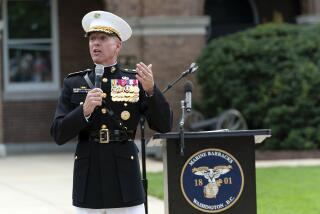Wallace Greene, 95; Top Marine During Vietnam War Buildup
- Share via
Wallace M. Greene Jr., a retired four-star general who was commandant of the Marine Corps during the buildup of U.S. forces for the war in Southeast Asia, died Saturday in Alexandria, Va. He was 95, and the cause of death was multiple myeloma.
During a 37-year career, Greene gained a reputation as a brilliant staff officer, long-range planner and troubleshooter.
He served as commandant from 1964 through 1967. In March 1965, when President Johnson ordered combat troops to what was then South Vietnam, a Marine regiment was the first American combat unit to enter the country. The U.S. presence eventually grew to about 500,000 troops, of whom about 70,000 were Marines.
Under Greene, the Marine Corps grew from 178,000 to nearly 300,000 active-duty personnel.
As chief of staff of the Marine Corps and then as commandant, Greene sponsored and encouraged a small group of officers to look 20 years into the future to see what a modern battlefield might be like and what it would require. The result was a study called MarCor 85, and its broad outlines are part of Marine Corps doctrine today.
A key proposal was training individual infantrymen to spot targets and use satellite positioning and “terminal guidance” systems to call in artillery, airstrikes or rockets.
These techniques have been used by Marines and Army Special Forces in campaigns from the Persian Gulf War in 1991 to Afghanistan.
Wallace Martin Greene Jr. was born in Waterbury, Vt., on Dec. 27, 1907. He was a descendant of Revolutionary War hero Nathaniel Greene. He graduated from the Naval Academy in 1930 and was commissioned a second lieutenant in the Marine Corps.
His early assignments included duty aboard the battleship Tennessee and a period studying chemical warfare at Edgewood Arsenal in Maryland. From 1937 to 1939, he was stationed with the 4th Marine Regiment in Shanghai.
This was the period of Japan’s expansion into China, and the Marines helped provide security to the International Settlement.
During World War II, Greene was a naval observer in London and then a staff officer in American Samoa. In 1944, he helped plan operations in the Marshall Islands and the invasions of Saipan and Tinian in the Mariana Islands.
After the war, Greene graduated from the National War College and had assignments at Quantico Marine Corps Base, Marine Corps headquarters in Washington, Hawaii and elsewhere. He also served on the staff of the Joint Chiefs of Staff.
In 1956, Greene was ordered to the Marine recruit depot at Parris Island, S.C., where six recruits had drowned during an unauthorized night training march. The tragedy shook the Marine Corps to its foundations.
Greene was put in charge of recruit training there and later served as commanding general of the base.
He ended such long-standing practices as mass punishments and physical abuse of recruits.
In 1958, Greene was assigned to Marine Corps headquarters. In 1960, he was named chief of staff, the No. 2 position in the corps at that time. In October 1963, he was nominated by President John F. Kennedy to be commandant.
In addition to meeting the requirements of the war in Vietnam, Greene centralized and reorganized the management of Marine personnel and equipment. He served until Dec. 31, 1967, and then retired.
Survivors include a son, Wallace M. Greene III, a retired Marine lieutenant colonel, of Arlington, Va.; and a daughter, Vaug.
More to Read
Sign up for Essential California
The most important California stories and recommendations in your inbox every morning.
You may occasionally receive promotional content from the Los Angeles Times.













